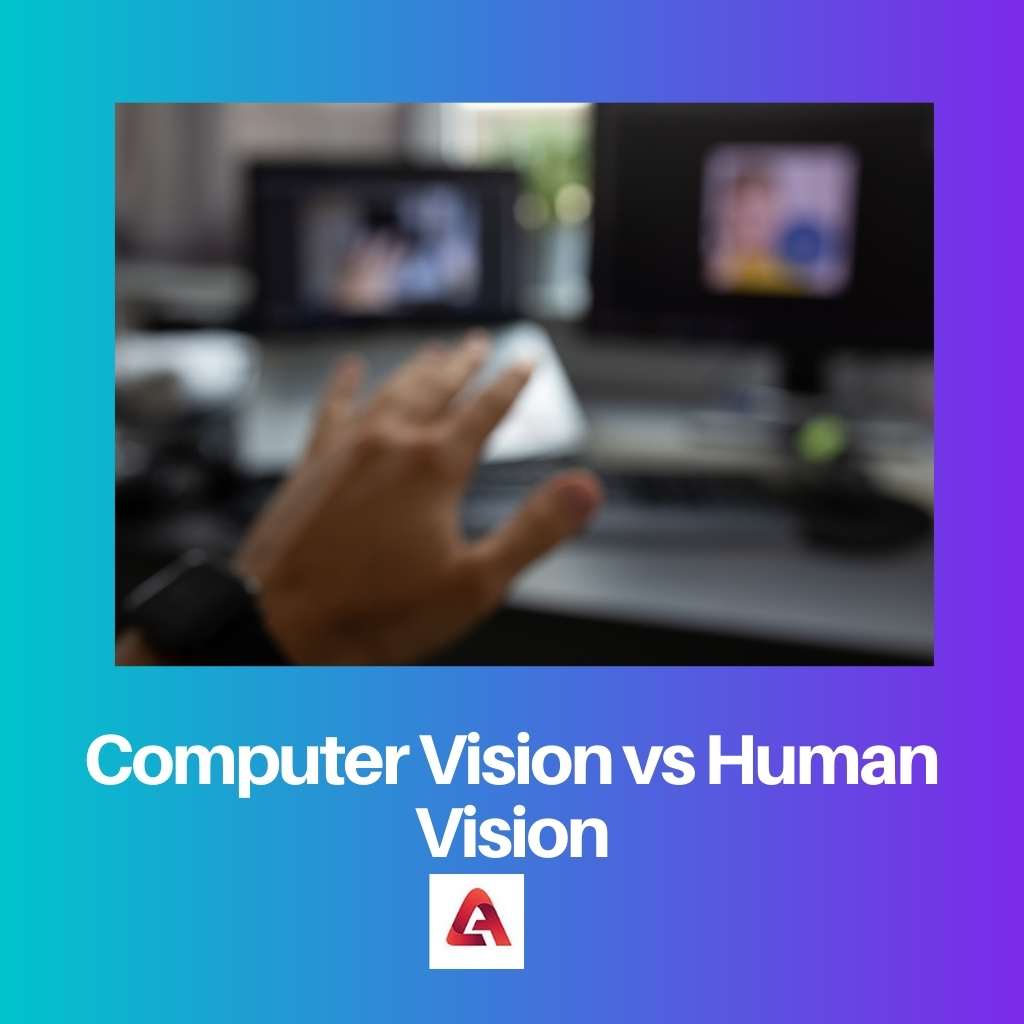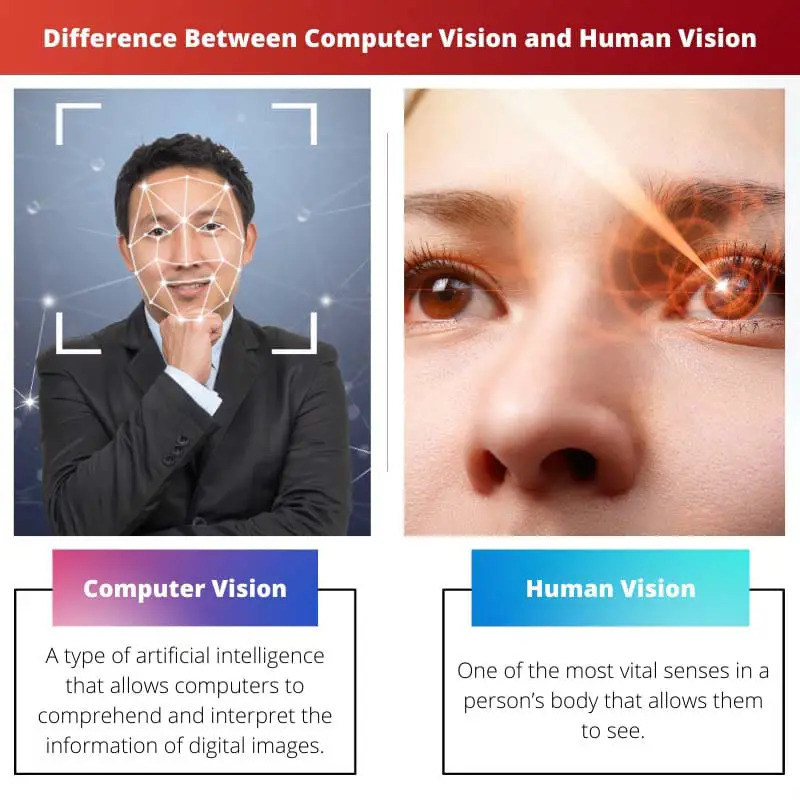Although there are many parallels between computer vision and human vision, both concepts are distinct from one another.
Scholars are attempting to get knowledge on human vision because it is a complex process to comprehend.
Computer vision, on the other hand, is a human technical innovation aimed at achieving human visual capabilities.
Key Takeaways
- Computer vision relies on algorithms and artificial intelligence to interpret visual data, whereas human vision depends on the brain’s processing of information from the eyes.
- Human vision is more adaptable and efficient in recognizing patterns, while computer vision can struggle with complex scenes or varied conditions.
- Computer vision can process vast amounts of data quickly and accurately, surpassing human capabilities in certain tasks, such as object recognition.
Computer Vision vs Human Vision
Human vision is influenced by lighting conditions, color, contrast, and visual acuity, and involves the integration of information from multiple sensory channels. Computer vision is used in a variety of applications, such as robotics, autonomous vehicles, surveillance, medical imaging, and augmented reality.

Computer vision is a technological scientific discipline that analyzes how computers can learn to recognize digital images or videos to a greater extent.
It aims to comprehend and perform actions that the human visual system is capable of performing. Computer vision tasks cover a wide range of tasks that human eyesight can perform.
Vision, like the other five senses in the human body, is one of the most essential.
Visual perception is the ability to perceive the world in different ways using light in the visible spectrum reflected by other objects through color vision, photopic vision, mesopic vision, and scotopic vision.
The interesting point is that human eyesight is a more sophisticated knowledge that has yet to be fully understood.
Comparison Table
| Parameters of Comparison | Computer Vision | Human Vision |
|---|---|---|
| Definition | A type of artificial intelligence that allows computers to comprehend and interpret the information of digital images. | One of the most vital senses in a person’s body that allows them to see. |
| Need Of Light | One of the most vital senses in a person’s body that allows them to see. | Light is not required for computer vision to sense its surroundings. |
| Use Of Algorithm | It requires an algorithm to include human vision. | It does not require an algorithm to see. |
| Process Complexity | It is not a difficult process to comprehend. | It’s a complicated process that hasn’t been fully grasped. |
| Object Recognition | One of the most difficult processes in computer vision is object recognition. | Objects are easily recognized by humans. |
What Is Computer Vision?
Computer vision is a branch of artificial intelligence (AI) that instructs machines how to interpret and comprehend the virtual environment. Many people nowadays are reliant on computer vision.
Since it works faster than humans, computer vision employs a variety of approaches to complete its tasks.
Computer vision is the systematic extraction, interpretation, and comprehension of relevant information from a single picture or a collection of images.
It entails the creation of a theoretical and algorithmic foundation for autonomous visual comprehension.
Computer vision is a technology that aspires to perform at the same level as human eyesight. In previous ages, computer vision was treated with skepticism.
Individuals believed that human vision is superior because it functioned smoothly. Humans do not take the time to identify an object, regardless of its shape, size, or color.
However, the human eye can’t see blur things in the rough, but in the case of computer vision, this isn’t a significant concern.
To attain a high level of visibility, computer vision has undergone numerous methodologies, algorithms, machine learning, and other types of training. Without the assistance of a person, computer vision can recognize images.
Deep learning techniques’ progress has given new life to the uter vision.
What Is Human Vision?
Human vision, sometimes known as ‘eyesight,’ is one of the most significant senses in the human body. It is the ability to observe and understand one’s surroundings without complication.
We can see books on a shelf, a dog running, and a circle with different colour shouting straining our vision. All of this depends on the eye, and which entirely dependent on light.
The light enters the eye through the cornea and is concentrated on the retina, a light-sensitive membrane at the back of the eye, by the lens. After that, the image is inverted.
Human vision coordinates with the eye, but it also corresponds with the brain to function to iWeb to see a particular number of general forms and patterns.
To identify an object in an image the closer we get, the less likely we are will use out what it is. Surprisingly, deep learning outperforms humans in this scenario.
Numerous experiments and procedures have been tried to comprehend the n vision. And it was understood, but not totally; there is still a long way to go.
Even a person with0/20 vision may experience difficulties with visual perceptual processing.

Main Difference Between Computer Vision and Human Vision
- Computer vision does ndoes require any light sensors. In the case of the human visual, there are two types of light sensors.
- In computer vision, machine learning techniques and algorithms detect, discriminate, and classify objects based on size or colour. Human idea is all about using one’s eyes to comprehend the environment, images,os.
- Computer vision has challenges regarding object recognition because it must conduct the entire procedure to understand the item. However, object recognition is relatively simple in the case of human vision. It works flawlessly because people rapidly understand and see things even if they’ve never seen a below-ground object.
- Machines are outfitted with external mechanisms and technologies, such as computer vision technology, to speed up the process, unlike humans, which are biologically programmed to see.
- Computer vision aspires to see like human vision, whicwhich constantly improvesuman vision. However, in the case of human vision, it is not the same.

- https://books.google.com/books?hl=en&lr=&id=CN9n2ZvyzlMC&oi=fnd&pg=PR9&dq=Computer+vision+and+human+vision&ots=3K_BLrjCWG&sig=0QaZVjMsLtrbDCS9zAVfSwNEPNc
- https://books.google.com/books?hl=en&lr=&id=Pe7gG0LxEUIC&oi=fnd&pg=PR7&dq=Computer+vision+and+human+vision&ots=O6q6FzJ8QT&sig=gnl2xSNuPdhFrKwNP79OOyqPR-0

Humans are capable of so much with their vision, it’s hard to imagine computers surpassing that.
The human eye is certainly a marvel. The potential of computer vision to be as proficient as human vision is intriguing.
I didn’t know the comparison between human and computer vision was so intricate. Very interesting!
It is such a fascinating topic! I didn’t know there was so much to learn from computer vision.
This is an area where humans undoubtedly excel. I mean, computers can’t see in the same way we do, can they?
So, are we supposed to believe that a computer can see like a human? I find that hard to believe.